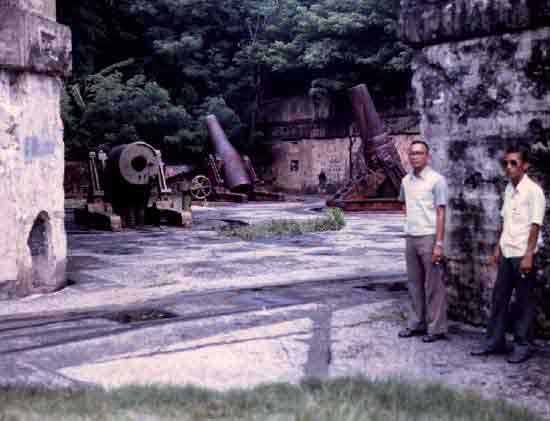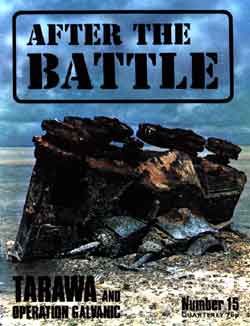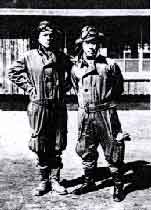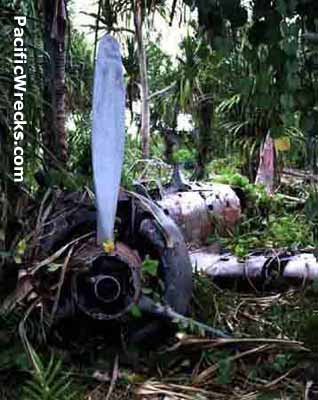Tell about your interest in WWII Pacific?
 In
early 1942, I was nine years old and completely obsessed with World
War II, particularly MacArthur's stand in the Philippines, but also
later in the year with the Guadalcanal campaign. I didn't think about the war as I was growing
up and pursuing my studies, culminating with a PhD in economic
development at the University of London.
In
early 1942, I was nine years old and completely obsessed with World
War II, particularly MacArthur's stand in the Philippines, but also
later in the year with the Guadalcanal campaign. I didn't think about the war as I was growing
up and pursuing my studies, culminating with a PhD in economic
development at the University of London.
While in London 1963-69 for my studies, I visited
the Imperial War Museum (IWM) and was hooked on the exhibits there of
WWII events, which had the effect of rekindling my interest in
the Pacific War. Since I could find so little written
on it, I decided to find out about it directly from the participants
and, eventually decided to write about it myself.
What Pacific locations have you visited?
I visited most of the
battle sites in the Central and South Pacific during 1974-1986. My first trip to the Pacific was
in August 1973, when I took up a 2-year UN assignment in Fiji as manpower planning
advisor to the government. One reason I opted for this assignment was the opportunity
afforded to visit all the old battle sites and search for any relics still there.
 My first battle site
visited was Funafuti, in the former Ellice Islands, in November 1974, the first
stop on a visit extending up the Ellice and into the Gilberts that involved layovers
in Nukufetau (B-24 base in 1943), Nanomea, Tarawa, Makin, and Abemama. It was quite an experience in itself to reach these sites, starting out with a
flight from Fiji to Funafuti, then a trip on an inter-island ship the Nareau to
Nukufetau and Nanomea in the Ellice (captain provided me with his launch for the
day's stopover in each place), and finally to Tarawa. From Tarawa I flew on a
local plane to Makin and Abemama.
My first battle site
visited was Funafuti, in the former Ellice Islands, in November 1974, the first
stop on a visit extending up the Ellice and into the Gilberts that involved layovers
in Nukufetau (B-24 base in 1943), Nanomea, Tarawa, Makin, and Abemama. It was quite an experience in itself to reach these sites, starting out with a
flight from Fiji to Funafuti, then a trip on an inter-island ship the Nareau to
Nukufetau and Nanomea in the Ellice (captain provided me with his launch for the
day's stopover in each place), and finally to Tarawa. From Tarawa I flew on a
local plane to Makin and Abemama.
 I didn't visit Clark Field, for which official passes were required when I was
in the Philippines in 1977. But I believe there are very few remains of the 1941-42
period surviving there today, just a few buildings. The
fortifications on Corregidor and especially Caballo, I've heard that many of the
guns have been illegally removed by locals collecting scrap. What
a shame!
I didn't visit Clark Field, for which official passes were required when I was
in the Philippines in 1977. But I believe there are very few remains of the 1941-42
period surviving there today, just a few buildings. The
fortifications on Corregidor and especially Caballo, I've heard that many of the
guns have been illegally removed by locals collecting scrap. What
a shame!
Locations I have visited:
Eliice and Gilbert Islands;
Guadalcanal, Gizo, Munda and Ballalae in
the Solomons;
Efate and Esperitu Santo in the New Hebrides;
Rabaul, Port Moresby, Deboyne Lagoon in PNG;
Noumea in New Caledonia;
Majuro and Maloelap in the Marshalls;
Ponape in the Carolines;
Corregidor and Bataan in the Philippines;
And of course Fiji
when I was based there 1973-75.
Talk about your articles published in magazines
 I'd seen an issue of After the Battle and contacted the editor, Winston Ramsey to see if he would be interested
in Pacific War wreck discovery stories, using a "then and now" approach. He was enthusiastic so I sent him the story
of my Gilbert & Ellice Islands trip of November 1974. I then followed
up with a story on my 1975 Solomon Islands visit, my 1977 Philippines
explorations, and my 1986 Maloelap search (this while on a UN mission
to the Marshall Islands) The editor wanted more stories, but
by then my UN-sponsored missions to the unexplored parts of the
Pacific were not forthcoming. Writing on the Pacific War is always sandwiched
in between consultancy missions for the United Nations, World Bank,
USAID to developing countries in various parts of the world.
I'd seen an issue of After the Battle and contacted the editor, Winston Ramsey to see if he would be interested
in Pacific War wreck discovery stories, using a "then and now" approach. He was enthusiastic so I sent him the story
of my Gilbert & Ellice Islands trip of November 1974. I then followed
up with a story on my 1975 Solomon Islands visit, my 1977 Philippines
explorations, and my 1986 Maloelap search (this while on a UN mission
to the Marshall Islands) The editor wanted more stories, but
by then my UN-sponsored missions to the unexplored parts of the
Pacific were not forthcoming. Writing on the Pacific War is always sandwiched
in between consultancy missions for the United Nations, World Bank,
USAID to developing countries in various parts of the world.
My articles and photos appear in:
After the Battle #15 (Tarawa and Operation Galvanic)
After the Battle # 23 (Corregidor)
After the Battle #54 (Unknown Maloelap)
I have written for other magazines too:
Glimpses of Micronesia (Maloelap: Japanese Naval Bastion of WWII)
Air Power (WWII's Pacific Graveyards)
Victory Fever on Guadalcanal: Japan's First Land Defeat of World War II the failure of the first attempt of the Japanese to seize
Henderson Field from the Marines, August 21, 1942, as experienced by
combatants on both sides.
Tell about your published books
Doomed at the Start (1995) the main difficulty faced
in writing was the paucity of official records,
most not surviving the campaign. But even those I found did not give
the detail I needed or provide the human dimension I sought. As a result, I relied
mainly on diaries kept by the pilots, which in many cases they
only grudgingly lent to me after pleas extending over years. It took 13 years of
research and writing to produce the book, which had to be put
together like a giant jig saw puzzle of many individual experiences.
December 8, 1941 (2003) is a detailed analysis of the plans and arrangements for the
build up of airpower in the Philippine Islands, November 1940-December
7, 1941, the Japanese preparations for the attack on the Philippines,
September-December 7, 1941, and the events of the actual attack
of December
8, 1941, experienced by combatants on both sides.
Every Day a Nightmare American Pursuit Pilots in the Defense of Java, 1941-1942 (2010) is the story of the experiences of the P-40 pilots diverted
to the Dutch East Indies to try to stem the Japanese air and sea invasion
of the Indies, January-March 1942.
Victory Fever on Guadalcanal (2014) details the Battle of the Tenaru on August 21, 1942 at the mouth of "Alligator Creek" (Ilu River) on the north coast of Guadalcanal.
Tell about your work with Veterans
 I
have corresponded with Japanese veterans, including Zero pilots who attacked Clark Field on
December 8, 1941, the 252 Kokutai pilot based on Taroa on Maloelap
(mentioned in my article), and "Pistol Pete" of Guadalcanal campaign fame (now
deceased), who was my main source of information on Japanese experiences during
the campaign. I've had no contact with Japanese Army Air Force pilots, just Navy
pilots. The veterans who participated
in the Pacific War are now in their very late 70s and early 80s. It is a race against
time to record their memories of combat in the various Pacific campaigns.
I feel I have an obligation to them to ensure that the public knows
of the sacrifices they made for the country.
I
have corresponded with Japanese veterans, including Zero pilots who attacked Clark Field on
December 8, 1941, the 252 Kokutai pilot based on Taroa on Maloelap
(mentioned in my article), and "Pistol Pete" of Guadalcanal campaign fame (now
deceased), who was my main source of information on Japanese experiences during
the campaign. I've had no contact with Japanese Army Air Force pilots, just Navy
pilots. The veterans who participated
in the Pacific War are now in their very late 70s and early 80s. It is a race against
time to record their memories of combat in the various Pacific campaigns.
I feel I have an obligation to them to ensure that the public knows
of the sacrifices they made for the country.
Recovery or rust in peace?
 I
believe a relic should be left in its original location if it
is to have historical significance. Of course, relics risk being hauled
off by the locals for their own practical needs -- using Marsden
matting for pig pens,aluminum from aircraft for combs, etc.
I
believe a relic should be left in its original location if it
is to have historical significance. Of course, relics risk being hauled
off by the locals for their own practical needs -- using Marsden
matting for pig pens,aluminum from aircraft for combs, etc.
On Taroa island on Maloelap, I found
a Japanese sake bottle in a gun pit and for a moment was tempted
to take it home, but instead reinserted it in its little pocket
in the tangled brush in the pit for others to see some day (but
hopefully not to remove).
Mention some of your awards.
Col. Robert D. Heinl Jr. Memorial Award 1998 for
best article on Marine Corps history published in 1997, awarded
by the Marine Corps Heritage Foundation.
Rear Admiral Ernest M. Eller Naval History Prize
2002 awarded by the Naval Historical Center and the Naval Historical
Foundation.
Arthur Goodzeit Award for best book on military
history published in 2003, awarded by the New York Military
Affairs Symposium (for December 8, 1941).